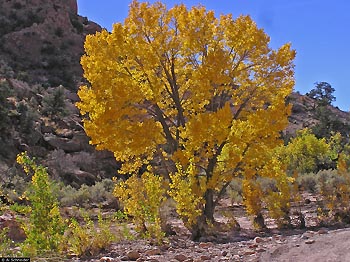Fremont Cottonwood

Common Name(s):
Fremont Cottonwood
Scientific Name:
Populus fremontii S. Wats.
Scientific Name Synonyms:
None known
Symbol:
POFR2
Description:
Life Span: Perennial
Origin: Native
Season: Deciduous
Growth Characteristics: Fremont cottonwood is Utah's largest or most massive deciduous tree. Its main trunk may reach 48 inches in diameter at the base. Large widespreading limbs begin leaving the trunk near the ground resulting in a very broad crown, often as broad as the tree is high, which averages about 70 feet. Fremont cottonwood reproduces both from seed and vegetatively.
Flowers/Inflorescence: Inflorescence is a long catkin, up to 6 inches long, consisting of a spike with many small imperfect and incomplete flowers.
Fruits/Seeds: Seeds are very small, "cotton"-covered, and borne in egg-shaped capsules. Suitable recruitment sites are created by the floodwaters of spring run-off. Seeds germinate almost exclusively on the freshly deposited, exposed alluvium left by receding floodwaters. The availability of this type of moist, exposed habitat during the 6 to 8 weeks after seed dispersal is crucial because of the limited period of seed viability.
Leaves: Broad, roughly triangular, with blade margins coarsely toothed with tooth tips rounded. The leaf stalk is long and flattened. The leaves are yellow-green all summer, turning yellow in autumn as they fall. Buds are long, about ¾ inch, resinous, and covered with shiny brown scales.
Stems: Twigs are stout and yellow-brown in color. Bark is light green and smooth on young stems, becoming thick, gray, and vertically furrowed on mature trunks. The wood is brittle, soft, light in weight, and decays readily. Sapwood is whitish tan and the heartwood is light brown.
Ecological Adaptions:
Fremont cottonwood is found mostly along low elevation (seldom above 6,000 feet) stream channels that are constantly moist. It may also be scattered in moist valley bottoms. It is shade intolerant. Reproduces easily from cuttings and growth is rapid.
Cottonwood species reproduce vegetatively by sprouting from stumps and root crowns, by forming suckers (adventitious shoots on roots), and from stem cuttings.
Soils: Well-drained, alluvial, sandy to sandy-clay loams with varying degrees of organic matter, clay or other fine soil and rock deposits.
Associated Species: Saltcedar, coyote willow, saltgrass, woods rose.
Uses and Management:
Fremont cottonwood has been used mainly in the past for fuel and fence posts. Its principal uses today are for streambank protection, wildlife food and shelter, and shade for livestock and recreation facilities. It is also grown for ornamental plantings and windbreaks.
Native Americans ate the inner bark of Fremont cottonwood for antiscorbutic. The bark and leaves were used to make poultices to relieve swelling, treat cuts, cure headaches, wash broken limbs, and to treat saddle sores and swollen legs of horses. The twigs were used by the Pima for basket materials, and Cahuilla tribes used the wood for mortars and tools. In northern Mexico, small industries utilize the wood to make bowls and small statues. Fremont cottonwoods were used by the Pueblo tribes for drums and were the preferred wood species for Quechan cremations.

